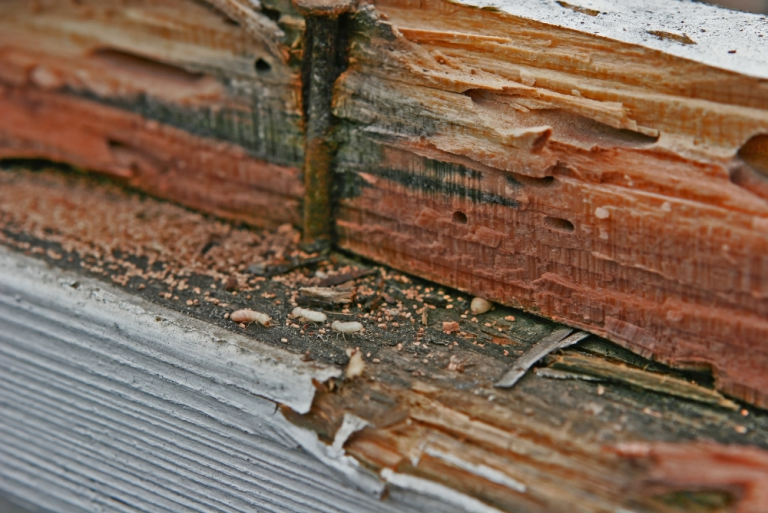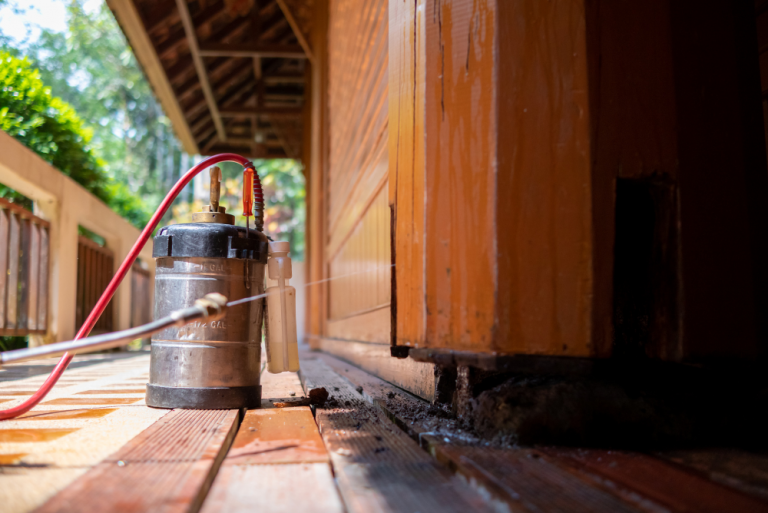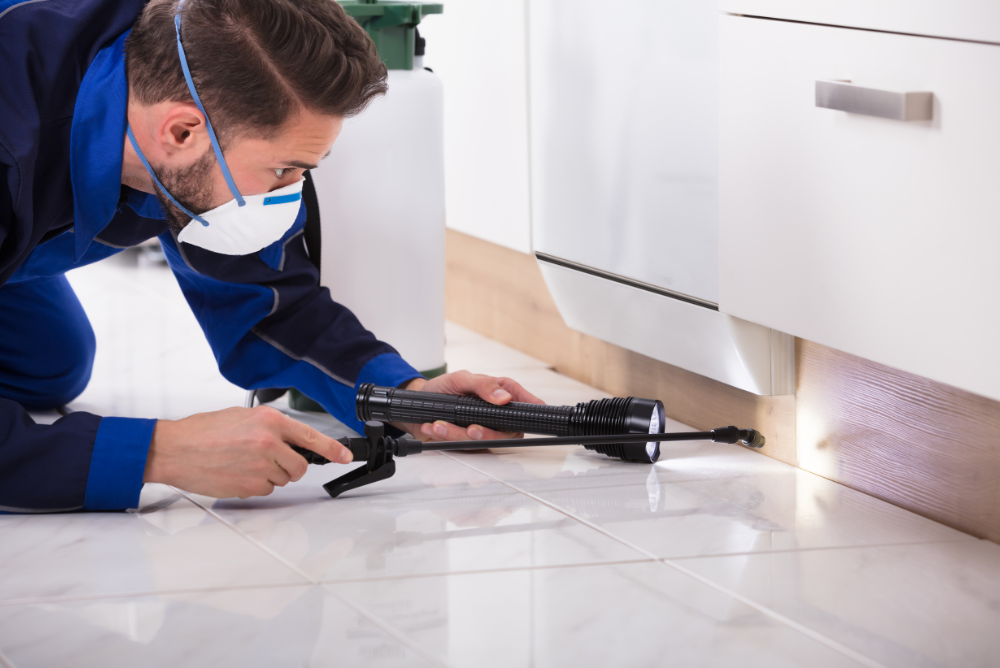Termites are among the most destructive pests in Singapore, silently damaging homes and businesses. If left untreated, they can compromise the structural integrity of your property, leading to costly repairs. Understanding how termites invade, the early warning signs, and effective termite control in Singapore is crucial in protecting your investment.
How Termites Damage Your Home

1. Silent Yet Destructive
Termites feed on wood, paper, and other cellulose-based materials. They often go undetected until significant damage is done, as they typically consume wood from the inside out. By the time signs of an infestation become visible, the structural integrity of your home may already be compromised.
Common Areas Affected:
- Wooden furniture: Termites can hollow out wooden furniture, weakening its structure and leading to costly replacements.
- Door frames and window sills: These areas provide easy entry points for termites and are often the first to show damage.
- Flooring and walls: Termites can burrow beneath flooring and inside walls, making detection difficult. Warped or sagging floors may be an indicator of severe damage.
- Roofing structures: Termites can infest wooden beams and rafters, posing a significant risk to the stability of your roof.
- Foundations: Although concrete foundations are resistant to termites, cracks in the foundation can provide an entry point for subterranean termites to reach wooden structures.
Termites weaken the materials they consume by creating intricate tunnels and hollowing them out. This gradual deterioration can lead to expensive repairs and, in severe cases, structural collapse. Homeowners may only realize the extent of the damage when furniture or flooring suddenly gives way.
2. Common Types of Termites in Singapore
Singapore is home to several termite species, each posing different threats:
Subterranean Termites
- The most destructive type, subterranean termites live underground and build extensive colonies.
- They enter homes through mud tunnels, which help them maintain moisture levels as they search for food.
- These termites are responsible for significant structural damage, often going unnoticed until it’s too late.
Drywood Termites
- Unlike subterranean termites, drywood termites do not need soil contact to survive.
- They infest dry wood, such as furniture, door frames, and wooden beams.
- Because they live within the wood they consume, their presence can go unnoticed for years.
- They produce small, pellet-like droppings (frass) that can indicate an infestation.
Dampwood Termites
- These termites thrive in moist environments and prefer decaying wood.
- They are less likely to infest homes but can become a problem in properties with leaks or poor ventilation.
- Addressing moisture issues can help prevent dampwood termite infestations.
Understanding the different types of termites and the damage they cause is essential in implementing effective termite control in Singapore. Regular inspections and preventive measures can help safeguard your property from these silent destroyers.
Early Warning Signs of a Termite Infestation

Recognizing early signs can help prevent severe damage. Be vigilant and watch for the following indicators:
- Mud tubes: These pencil-sized tunnels appear along walls, ceilings, or wooden structures. Termites use them for travel and to maintain a humid environment, protecting them from exposure. Finding mud tubes is a strong sign of an active infestation.
- Hollow-sounding wood: If you tap on wooden surfaces such as door frames, walls, or flooring and they sound hollow, termites may have consumed the interior, leaving only a fragile outer shell.
- Discarded wings: After termites swarm to establish a new colony, they shed their wings. Finding piles of translucent wings near windows, doors, or light fixtures is a key sign of an infestation.
- Frass (termite droppings): Drywood termites leave behind tiny, pellet-like droppings that resemble sawdust or fine wood dust. These often accumulate near infested furniture or wooden structures.
- Warped or bubbling paint: Moisture buildup caused by termites tunneling inside walls can result in peeling, bubbling, or distorted paint. This is often mistaken for water damage, leading to misdiagnosed repairs.
- Difficulty opening doors and windows: Warped wood caused by termite activity can make doors and windows stick or become harder to open and close. This is often one of the earliest signs homeowners notice.
- Clicking sounds inside walls: Some termite species, particularly soldier termites, make faint clicking or tapping noises when disturbed. These sounds come from termites communicating with each other by banging their heads against tunnel walls.
- Sagging floors and ceilings: Severe infestations can weaken wooden flooring and ceiling structures, leading to noticeable sagging or soft spots.
If you notice any of these warning signs, act quickly. Contacting a professional pest control service for an inspection can help prevent costly repairs and further infestation.
Effective Termite Control in Singapore
Professional Termite Inspection Regular inspections by pest control professionals can help detect infestations early. Experts use specialized tools like moisture meters and thermal imaging to identify hidden termite activity. These inspections help homeowners take preventive measures before termites cause significant damage. Professional inspections should be scheduled annually, especially for properties with a history of termite problems.

1. Termite Treatment Methods Several professional treatments are available:
- Termiticide Soil Treatment – A chemical barrier is applied around the property to prevent termites from entering. This method is effective in eliminating subterranean termites by blocking their access points.
- Baiting Systems – Slow-acting bait stations attract termites and spread the toxin throughout the colony. This method ensures that the queen and worker termites are eradicated, leading to complete colony elimination.
- Foam Treatment – Expands within wooden structures, reaching hidden colonies. The foam penetrates cracks and crevices, providing targeted control in areas with active infestations.
- Wood Treatment – Protective coatings and borate-based solutions deter termites from infesting wooden structures. This treatment not only eliminates termites but also prevents future infestations by making the wood unpalatable to them.
2. Preventive Measures Taking preventive steps can reduce the risk of an infestation:
- Keep wood and cellulose-based materials away from direct soil contact. Store firewood and construction materials off the ground to minimize the risk of termite access.
- Fix leaks and moisture issues to deter dampwood termites. Termites thrive in damp environments, so addressing plumbing leaks, poor drainage, and condensation issues can help prevent infestations.
- Seal cracks and crevices in walls and foundations. Small openings in the foundation or around windows and doors can serve as entry points for termites. Sealing these gaps helps protect the home from intrusion.
- Schedule annual termite inspections with a professional service. Regular check-ups ensure early detection and treatment, reducing the risk of extensive structural damage.
- Maintain proper ventilation in crawl spaces and attics. Good airflow reduces humidity levels, making the environment less attractive to termites.
- Use termite-resistant building materials when constructing or renovating. Opting for treated wood and concrete barriers can provide long-term protection against termite damage.
By implementing these effective termite control strategies, homeowners in Singapore can safeguard their properties from costly termite damage. Professional pest control services play a crucial role in identifying, treating, and preventing infestations, ensuring peace of mind for residents.
Choosing the Right Termite Control Service in Singapore
Selecting a reputable pest control company ensures effective termite management. Consider the following factors:
- Experience in termite control
- Use of environmentally friendly treatment methods
- Certified and licensed professionals
- Positive customer reviews and testimonials
Why Professional Termite Control is Essential
DIY termite control methods often provide temporary relief but fail to eliminate the entire colony. Termites are highly resilient pests, and without a comprehensive approach, infestations can quickly return. Professional termite control in Singapore ensures long-term protection through advanced techniques, industry-grade treatments, and ongoing prevention strategies.
- Advanced Detection Tools Professional pest control companies use specialized equipment to detect termite activity in hidden areas. Some of these advanced tools include:
- Moisture meters – Identify areas with excessive moisture, which attract termites.
- Thermal imaging cameras – Detect heat signatures of termite colonies within walls and floors.
- Acoustic sensors – Pick up sounds of termites feeding within wooden structures.
- Endoscopes – Allow professionals to inspect hard-to-reach spaces without invasive procedures.
- Industry-Grade Treatments Professional exterminators use powerful treatments that are more effective than over-the-counter solutions. These treatments include:
- Termiticide barriers – Applied to soil and structures to create a protective shield against termites.
- Baiting systems – Designed to attract termites and gradually eliminate the entire colony.
- Foam and liquid termiticides – Injected directly into infested wood for thorough eradication.
- Fumigation treatments – Used for severe infestations where large areas need complete termite elimination.
- Long-Term Monitoring and Prevention Plans Professional services do not just eliminate termites; they provide long-term protection through:
- Routine inspections to detect early signs of termite activity.
- Preventive treatments to protect structures from future infestations.
- Customized plans tailored to specific property needs, ensuring comprehensive termite management.
By investing in professional termite control, homeowners in Singapore can avoid costly damage and enjoy peace of mind knowing their property is well-protected from these silent destroyers.
Frequently Asked Questions (FAQs)
The cost varies depending on the severity of the infestation and the treatment method used. A professional inspection can provide an accurate estimate.
Treatment duration depends on the chosen method. Baiting systems may take several weeks, while chemical treatments provide immediate results.
Yes, without preventive measures, termites can reinfest. Regular inspections and maintenance are essential to keep your property termite-free.
Conclusion
Termites are a serious threat to homes and businesses in Singapore. Identifying early warning signs and opting for professional termite control in Singapore can save you from costly repairs. Protect your property today by scheduling a professional inspection and implementing preventive measures. For expert assistance, visit All Out Pest Management.



